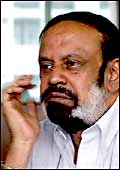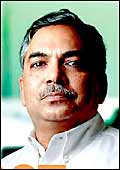|
 In
mid-may this year, G.R. Gopinath, the man who pioneered low-fare
aviation in India, was a worried man. The initial public offering
(IPO) of Deccan Aviation (Air Deccan is the brand) was all set
for launch, but the stock market was in the vice-like grip of
bear operators. Keeping its fingers crossed, Deccan went ahead
with the IPO, only to find that on the day of its opening (May
18), the bse Sensex tanked 826 points. The second day, the index
swung another 800 points. Faced with near-certain failure, the
company slashed the issue floor price of Rs 150 to Rs 146 and
extended the closing by three days. But as luck would have it,
the Sensex was at its volatile best the following week and swung
a record 1,111.7 points. With great difficulty, Deccan and the
issue's lead managers, Enam Securities and ICICI Securities, managed
to drag the IPO over the line, ensuring it was oversubscribed
a measly 1.23 times by May 26. In
mid-may this year, G.R. Gopinath, the man who pioneered low-fare
aviation in India, was a worried man. The initial public offering
(IPO) of Deccan Aviation (Air Deccan is the brand) was all set
for launch, but the stock market was in the vice-like grip of
bear operators. Keeping its fingers crossed, Deccan went ahead
with the IPO, only to find that on the day of its opening (May
18), the bse Sensex tanked 826 points. The second day, the index
swung another 800 points. Faced with near-certain failure, the
company slashed the issue floor price of Rs 150 to Rs 146 and
extended the closing by three days. But as luck would have it,
the Sensex was at its volatile best the following week and swung
a record 1,111.7 points. With great difficulty, Deccan and the
issue's lead managers, Enam Securities and ICICI Securities, managed
to drag the IPO over the line, ensuring it was oversubscribed
a measly 1.23 times by May 26.
Cut to mid-July and the mood at Air Deccan's
four-storey office on Bangalore's Cunningham Road could not be
more different. There's a new surge of optimism among Gopinath
and his top managers, thanks largely to a 2 per cent increase
in its June market share to 21.2 per cent, which puts it marginally
ahead of Indian. Not bad for an airline that took wings just three
years ago. (For the record, the state-owned carrier has disputed
Deccan's claim.) "This is a vindication of our low-cost model,"
beams Gopinath, a former army captain, who raised Rs 373 crore
from the sale of 24.5 million Deccan shares.
There's little doubt that low-fare airlines
have transformed the domestic market, never mind that a full-service
carrier, Jet Airways, still has the lion's share of 32 per cent.
Three years ago, less than 14 million passengers were flying the
domestic sectors every year. By the end of 2005, that figure stood
at about 28 million, and is expected to more than double over
the next four years. In that time, the no-frills carriers are
expected to increase their market share from 26 per cent to between
35 and 40 per cent. "Low cost is the way to go in the short-haul
market globally and the trend is catching up in India too,"
says Ajay Singh, Director, SpiceJet. Adds Jeh Wadia, Managing
Director, GoAir, another no-frills airline: "More than 60
per cent of the airline traffic is concentrated in Delhi and Mumbai.
As the low-cost carriers cover more cities, the options for train
passengers will increase and the market will see increasing depth
and width."
Low Fare, But Low Cost?
It is that promise that has drawn a number
of new players to the industry (see Crowded Skies). At present,
there are an estimated 17 to 18 million daily rail passengers
and another 10 to 12 million who travel by bus. "If we get
just 5 per cent of this, we could have 1.5 million people airborne
daily," points out Gopinath. Yet, if his investors aren't
rapturous over either Deccan's market share gain or the market
potential-the Deccan stock is down to Rs 74 from the list price
of Rs 148-it's because stiff price competition has ensured that
few airlines make profits. In Deccan's case, it is expected to
lose money at least uptill 2007-08.
Why? To put it simply, while Deccan is low
fare, it's not quite low cost. Blame it on the nature of the industry
and Deccan's own peculiar problems. Running an airline is an extremely
capital-intensive proposition. It costs anywhere between $225,000-$325,000
(Rs 1.06-1.53 crore) per month to lease an Airbus A320, which
is what Air Deccan flies on longer routes. Maintenance costs (including
mandatory 'maintenance reserve') can be as much as $150,000 (Rs
70.5 lakh) per plane for labour charges alone, with spares being
billed additionally. Employee costs (essentially pilot wages)
can be as high as 11 per cent of operating revenues. Fuel costs
take another third off the revenues. Do the math, and this is
how Deccan's costs are expected to break up as a percentage of
revenues in 2005-06: Fuel, 47 per cent; lease rentals, 15 per
cent; employee and maintenance expenses about 10 per cent each;
and commissions about 5 per cent.
| GOPI'S A-TEAM |
| Gopinath has hired
a raft of expats and experienced industry hands to boost the
carrier's growth. Here's a list of people who've co-piloted
Air Deccan to the #2 slot.
 Warwick
Brady Warwick
Brady
41/Chief Operating Officer
South African by birth and a pilot by training, Brady earned
his stripes with Ryanair, rising rapidly to be its Deputy
Director (Operations), with overall responsibility for Stansted
Airport in the UK. Hired by Gopinath in late 2005 to shore
up a faltering Air Deccan and given carte blanche to help
streamline the carrier's operations. Also the airline's
unofficial HR Head, so he has to manage poaching from rivals
and a seemingly never-ending quest for pilots.
 John
Kuruvilla John
Kuruvilla
43/Chief Revenue Officer
The former advertising and retail professional runs marketing
for Gopinath and finds new revenue streams to keep the low-fare
operator's costs down. Spearheaded the move to focus on
ancillary revenues (making money outside of air tickets)
for Air Deccan and sold innovative ideas to advertisers.
Wants to make previous cost centres like marketing into
a money-spinner.
 M.G.
Mohan Kumar M.G.
Mohan Kumar
48/Director (Finance)
From running a full-time chartered accountant consultancy,
Kumar moved quickly to minding Air Deccan's finances with
a tight leash. He is entrusted with finding money to fund
the airline's 96-aircraft acquisition spree and balancing
the carrier's low-cost ethos. Did face the heat for a poor
IPO, but continues to enjoy Gopinath's confidence.
 R.
Krishnaswamy R.
Krishnaswamy
63/Chief Corporate Planning
The oldest senior manager with Air Deccan, Krishnaswamy
has
the key responsibility of making sure Air Deccan's planes
spend
the most time in the sky and the least on the ground. A
35-year industry veteran, Krishnaswamy has to work his way
around the infrastructure
crunch at airports.
 Aravind
Saksena Aravind
Saksena
51/Chief Information Officer
Technology is a key cog in Air Deccan's low-fare model,
with Saksena, a 16-year army veteran, in charge of minimising
costs by moving online everything from tickets to inter-office
memos. Key player behind designing Air Deccan's one-page
ticket that cut costs to under a rupee per ticket compared
to Rs 40 shelled out by some competitors.
|
Some of Deccan's higher expenses are due
to its own mixed fleet and inefficiencies. Unlike the only other
listed low-fare airline, SpiceJet, Deccan operates a fleet that
comprises 14 A320s and 22 ATRs (smaller, 48- and 72-seater planes
that do feeder routes). That means the airline has to maintain
a duplicate set of everything: Pilots (they need to be type-certified;
an A320 certified pilot cannot fly an ATR and vice versa), engines
and spares, and maintenance engineers. In his quest to corner
market share, Gopinath has spread the airline thin, which means
some of his routes are not profitable at all. For example, early
August, the airline announced it was discontinuing its service
on the Delhi-Kanpur, Mumbai-Nashik and Lucknow-Kanpur routes for
being unviable. Once again, Deccan's flight dispatch and passenger
load factor (that is, capacity utilisation) aren't as good as
SpiceJet's. Not only does SpiceJet (earlier called Royal Airways
and prior to that ModiLuft) have the highest load factor of 86
per cent in the industry, but it boasts an impressive flight dispatch
rate of 99.5 per cent. Consider the irony, though: SpiceJet still
reported a net loss of Rs 41 crore on revenues of Rs 453.15 crore
in 2005-06, its first full year of operations.
The fact that SpiceJet operates a vastly
smaller, single-type fleet comprising just five Boeing 737-800s
and flies to only 12 destinations in the country, compared to
Deccan's 55, should have helped. If it didn't it only points to
the difficulty of making profits in this business. By that argument,
Deccan needs to pull up its socks even more. "Our on-time
record was terrible-just 60 per cent in February-April (2006).
We clearly had issues to resolve this problem if we wanted to
improve the airline's perception," says Warwick Brady, hand-picked
by Gopinath in end-2005 from global low-cost carrier Ryanair to
be Deccan's coo. When you are an airline, quick turnarounds of
the aircraft make or break your profits, since expenses are incurred
by the hour, and per landing and take off. So, one of the first
things Brady, 41, did was to fire 10 ground handling agents and
get new ones. Since his arrival, Deccan's on-time dispatch has
improved to 80 per cent, but some analysts still expect the airline
to report a net loss of Rs 171 crore for 2005-06 (results are
expected late September).
Staying Power
Gopinath knows only too well that market
share alone does not mean much. To become a profitable low-fare
airline, Deccan needs to wring cost out of its system. In fact,
that was the primary idea behind the IPO. For instance, of the
Rs 373 crore raised, Rs 133 crore will go towards repaying debt,
saving Deccan Rs 8-9 crore in annual interest charges. Brady also
says that the airline will invest about $25 million (Rs 117.50
crore) over the next couple of years in a 60,000-sq. ft hangar
in Chennai, engineering facilities and a pilot training centre
in Bangalore or Hyderabad. "The hangar facility is important
for us to undertake routine maintenance in-house to cut costs,"
says Andy Daines, Vice President (Engineering).
By the end of this financial year, Deccan
hopes to have a fleet of 19 A320s and 26 ATRs, and each aircraft
needs to undergo 10 days of annual scheduled (and unscheduled)
checks. At present, the aircraft are sent abroad for the mandatory
checks at a significant cost. "It costs us Rs 30-35 lakh
to fly an empty plane to Singapore and get it serviced every 4,000
km and then fly it back empty," says M.G. Mohan Kumar, Deccan's
Finance Director. "Instead, we are examining the possibility
of doing that in India and cutting this expense." A local
maintenance facility would also allow Deccan to troubleshoot unscheduled
groundings faster, thereby keeping its aircraft in the air longer.
Simultaneously, the airline, which has ordered
96 aircraft for delivery over 96 months, is trying to push its
non-fare revenues. Abroad, it is not unusual for low-fare carriers
to get as much as a quarter of their revenues from non-ticket
sales. In Deccan's case, the figure is just 9 per cent. "Your
imagination is your limit," says John Kuruvilla, Deccan's
Chief Revenue Officer, on the revenue potential. On that count,
the airline has been innovative. It has sold space on its aircraft
body to advertisers, monogrammed logos on headrests and even painted
the roof of its aircraft with the colours of an insurance company
for advertising rupees.
Gopinath's strategy seems to be simple: He
wants to woo an ever-increasing number of first-time flyers, fly
to newer destinations (including nearby countries), and continue
to give full-service airlines such as Jet Airways and Indian a
run for their money. But how to do all that while keeping his
costs pared to the bone is a tightrope walk he will have to perfect.
|





 I
I Warwick
Brady
Warwick
Brady John
Kuruvilla
John
Kuruvilla M.G.
Mohan Kumar
M.G.
Mohan Kumar R.
Krishnaswamy
R.
Krishnaswamy Aravind
Saksena
Aravind
Saksena